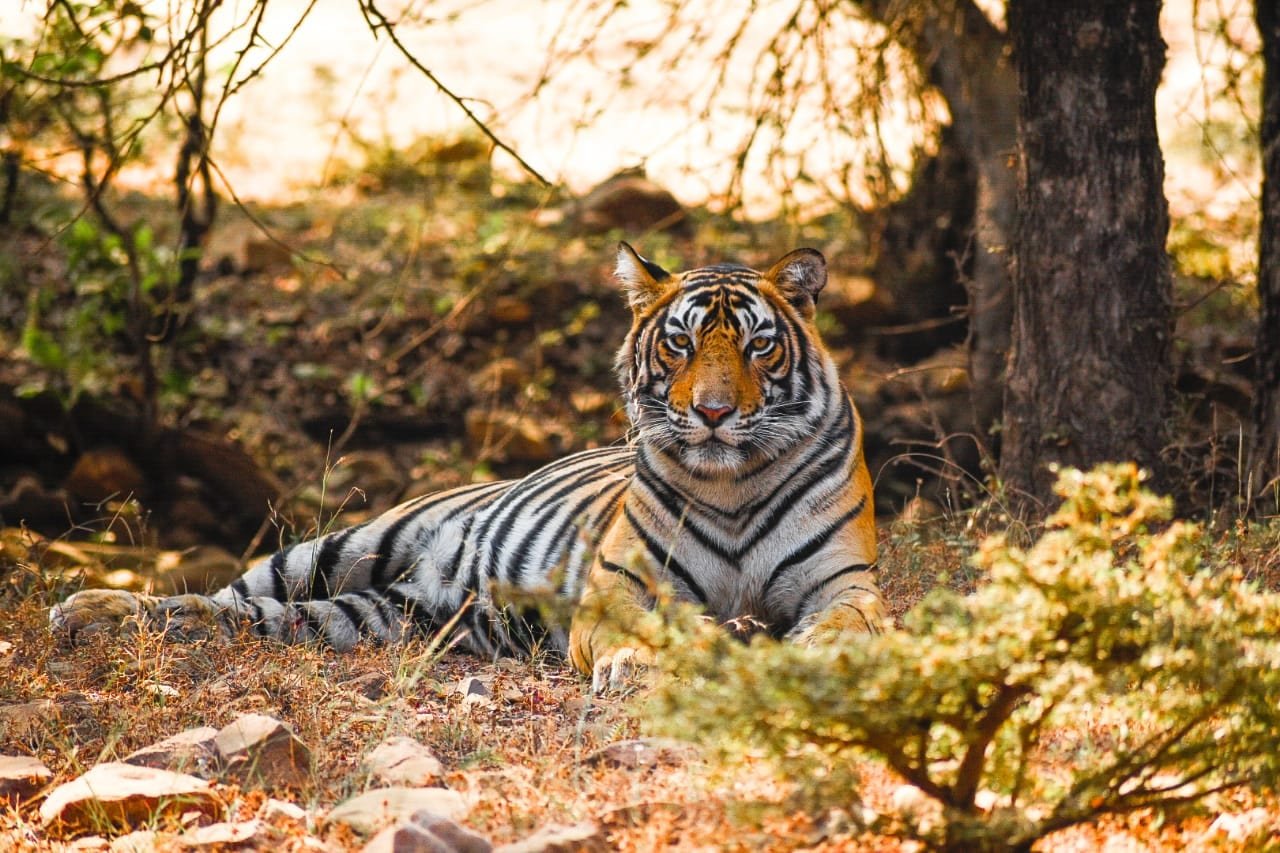
Out of many tiger species, the Royal Bengal Tiger species are the most renowned, especially in India. Tigers are the true symbol of power, patience, beauty, strength, and fearlessness. These are the largest carnivore animals in the cat family, whose current population is decreasing. Also, their status is among the endangered animals. Today, in this blog post we are going to reveal some amazing facts on the Royal Bengal Tigers.
If you are a wildlife enthusiast traveling to Indian wildlife sanctuaries and safaris, it will be fun, adventurous to witness tigers in action. But, the question is, where can you watch the Bengal tiger family peacefully with no disturbance?
In India, there are tons of wildlife national parks, providing homes to these endangered animals.
How Many Bengal Tigers Are Left in India?
In the 20th century, there were 1,00,000+ tigers. But, in the last 100 years, tiger hunting, tiger exploitation, poaching & forest destruction caused a decrease in the tiger population in India and the subcontinent.
“As per the recent Tiger Census report, 2018, around 3000 tigers are walking in the forests of India.”
The hunt for fun and increased population of humans are the major factors behind why are Bengal tigers endangered. That’s why the tiger conservation program is at its peak in India.
You can know more about this program by visiting the Regional Museum in Ranthambore, Rajasthan. Ranthambore National Park is the best because of its environment, landscape, and good tiger population. By doing a Ranthambore tiger safari booking, you get a chance to know bit-by-bit details about the life of a tiger, and you can watch them in action too.
Quick Scientific Facts of Bengal Tigers!
- Common Name: Royal Bengal Tiger
- Kingdom & Type: Animalia & Mammals
- Genus Specie Name: Panthera Tigris Tigris
- Best Habitat: Tropical forest, brush landscapes, marsh plains, and tall (dry and wet) grasslands
- Body Description: Black strips on their Orange color skin & fur, stoned-color eyes
- Bengal tiger size ranges from 3 m to 5 m, and its weight is between 300 lbs to 500 lbs
- Tiger’s sexual maturity occurs at the age of 3 to 5 years, and each female tiger give birth to 2 to 4 cubs
- The Bengal tiger lifespan is averagely not more than 15 years
- The current living status of these powerful nocturnal hunters is endangered
- A hungry tiger can eat 60 pounds of meat at a time
Fun Facts About Bengal Tigers!
Tigers are majestic creatures, and we all are the fans of their glorious walk. Among various species of tigers, the Royal Bengal Tiger family is the most loved one, dwelling in India, Bangladesh, Nepal, Myanmar, Bhutan, and in some lower parts of Southern Tibet.
Also Read: 10 Exciting Things You Can Do In Ranthambore
Though they are an endangered species, they interest all wildlife enthusiasts and forest travelers. The royal Bengal tiger facts that we will reveal today will stun you, will shock you. Your knowledge about the tigers’ lifestyle will jump at the highest level.
Below we have presented facts and unique qualities on their hunting techniques, their family relationship, their appearance, habitat, their roar, behavior, and more.
- Now, it’s time to know how these big cats are different from many carnivore animals and other species of the cat family. Next are some interesting facts on the tigers:
- Finding a white Bengal tiger in India is difficult.
- The Bengal Tiger’s canine teeth are the biggest among carnivorous animals.
- Bengal Tigers have big territory under their control; however, they are not social with other tigers.
- Also, they are good climbers and swimmers.
- They can kill their prey swiftly with a single blowing finish.
- Tigers are experts in imitating other animals’ sounds. This way they lure their prey.
- Male tigers are solo travelers, they mark their area with urine and scratch marks. This way they warn the trespassers.
- Tiger hunt in the dusk, evening, taking aid of the tall grasses. They can’t run long distances, that’s why they stalk and lunge at their prey.
- The tigers only roar when they need help, otherwise, they only fluff, spurr, and hiss; even during fighting. A tiger roar is hearable from 2 miles.
- Tigers are blind during the first week of their life. It is a similar characteristic to domestic cats.
- Tigers can run at a blazing speed of 60 km/h
- Royal Bengal Tigers care for their family. They are not like lions. After killing their prey, first females and cubs have the feast. Males eat after them.
- Tiger’s night vision is 6 times better than other animals and humans.
- Tigers have a strong memory and they remember faces.
- Their saliva is antiseptic in nature; that’s why they lick their wounds upon any injury. Also, they can stop the bleeding just by licking, no first-AID is required.
- The oldest tiger fossil was found in Sri Lanka. They have been present on earth for the last 16,500 years.
- For thousands of years, tigers hold an important place in India’s culture. Moreover, Tigers have a long literary legacy from Panchatantra Stories to The Jungle Book!
- India is a safe home to the world’s 70% of tigers. No two Bengal tigers have the same appearance and black stripes on their body.
- Around 20 years ago, the circus acts of Bengal tigers were an entertaining event. But, with the increasing Tiger Conservation Programs, all this is now at a stop!
Final Fact – Royal Bengal Tigers Want Help!
As mentioned above, the royal Bengal tigers are the subspecies in the tiger family. Also, you came to know about their population, their lifestyle, and some unique, unheard facts. Furthermore, you now know how important it is to prevent them and why!
Also Read: Do I Plan A Trip to Ranthambore National Park
According to some wildlife experts in India, the Bengal tiger’s population has increased; however, many believe that these tigers can go extinct in the next 30 years if the government doesn’t make better decisions for conserving the tigers.
The World Wildlife Foundation is doing a lot within its power to help these endangered species, but the results aren’t as expected.
To save tigers from extinction, we all have to take major actions, so that more can be learned about them!




No comment yet, add your voice below!